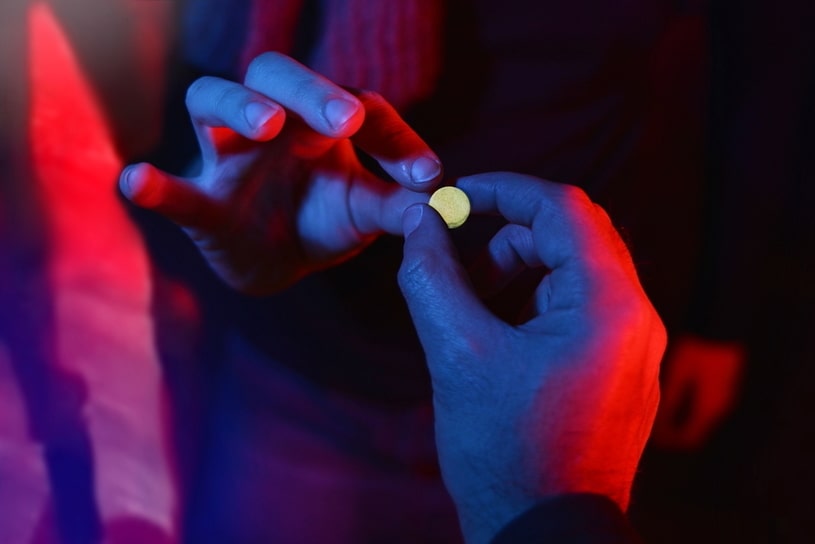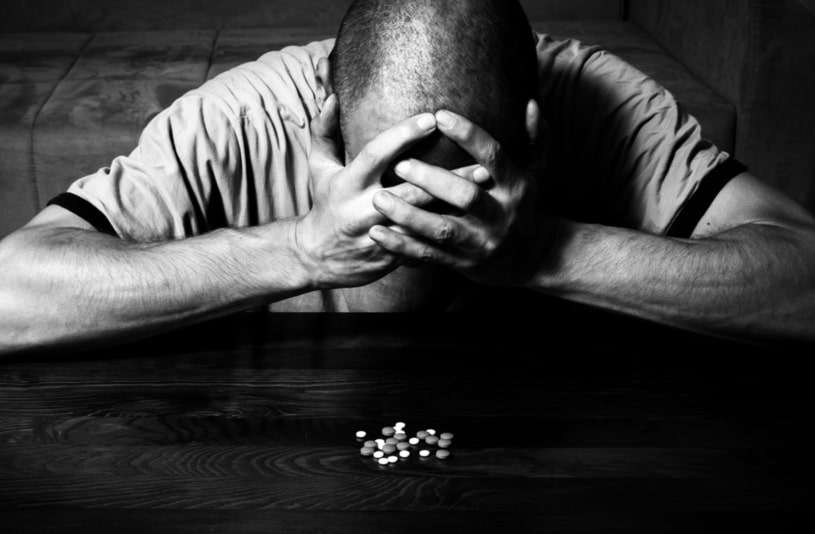MDMA (stands for 3,4-methylenedioxymethamphetamine) is a psychoactive substance that has both stimulant and hallucinogenic properties. It is also known as Ecstasy, E, X, Molly, Adam, and Mandy.
Table Of Contents:
It was first synthesized in 1912 and was known as Methylsafrylaminc. Originally made with medical use in mind, it eventually became a recreational drug decades later. However, there is still research ongoing to gain information on its use in the treatment of mental health conditions, sometimes known as MDMA therapy or psychotherapy.
It is frequently used at parties and clubs, and many get their first use of it in these environments. It is from abuse at such events that addiction can occur. Ecstasy addiction is a condition that occurs when a person is unable to achieve a normal mood without the use of the drug.
MDMA abuse is a likely possibility, and this can ultimately be dangerous. Unlike other substances, ecstasy addiction’s staging is yet to be well classified, which adds to the risk. When faced with an overdose or wanting to stop using a drug, the first thing to do is take an MDMA drug test to determine the level of the drug in the body. This will help doctors build a rehabilitation program.
What is ecstasy, and what are the dangers? This article will discuss ecstasy addiction, its symptoms, dangers, and how to treat it.
Ecstasy Drug Addiction Causes
Ecstasy being a street or party drug means that many addicts get their first use of it at parties or raves. After using it and feeling its effects, they may find themselves desiring those effects again. Following repeated use, the individual may notice that they crave molly and cannot achieve a normal mood state without using it. A person like this has an addiction to molly.

More About Illicit Drugs:
MDMA abuse and addiction are often psychological and due to the other substances mixed in with the drug, exaggerating its influence over the user. According to the National Institute Of Drug Abuse, molly targets the same neurotransmitters in the brain that some other addictive drugs do. This highlights the potential danger of getting hooked on it and other mdma side effects.
Due to rarely being over 10% in purity, MDMA abuse is always a significant health hazard. MDMA drug can be mixed with anything from caffeine and rat poison to cocaine, which makes it highly dangerous and can increase MDMA abuse.
Due to the flashing lights and music at raves and clubs, the use of MDMA drug is prevalent in these settings. However, addicts may use it at home or in public places. These are mostly young adults and teenagers using the substance. These reasons explain ecstasy being defined as a Schedule I substance by the DEA.
MDMA Mechanism of Action
Molly achieves its action by affecting three of the main neurotransmitters in the central nervous system. These are dopamine, norepinephrine, and serotonin.
- Large amounts of serotonin are released when a person uses this substance. This increase in serotonin will affect many of the central nervous system functions dependent on it. This includes its effects on mood, sexual function, appetite, and sleep.
- There is a significant release of norepinephrine. This results in physical symptoms, such as increased heart rate and blood pressure.
- There is also increased action of dopamine following the use of ecstasy. This is an important neurotransmitter in the reward system, contributing greatly to its addictive potential and pleasure felt after using. It also increases the user’s energy levels.
Signs and Symptoms of MDMA Abuse
Abusers of molly use it for specific effects which they desire from it. These are typically its effects on mood, energy, and sensory perception. However, other symptoms accompany its use due to its mechanism of action on the neurotransmitters affecting the central nervous system. Many of these are not desired by the user but frequently occur when it is abused. These can be both physical symptoms and signs, as well as psychological ones.
These symptoms can be either physical or behavioral.
The behavioral symptoms include:
- Disinhibition
- Mood changes
- Increased sexual desire
- Insomnia
- Increased alertness
- Lethargy
- Restlessness
- Visual and auditory hallucinations, in rare instances
The physical symptoms include the following:
- Dehydration
- Sweating
- Increased heart rate
- Increased blood pressure
- Loss of appetite
- Erectile dysfunction
- Increased body temperature
- Jaw tightness
MDMA Abuse Dangers
MDMA abuse can have dangerous effects on the body. Ecstasy addiction is only one of the dangers. Many of the other dangers can occur from even a single use of the substance.
One of the effects that molly has on the body is increasing muscle activity. The user will not notice this due to the substance’s influence. This increased muscle activity produces heat, the body sweats profusely to counteract this, and the person may become dehydrated as a result.
There is increased sexual desire following MDMA abuse. With the impulsivity that comes with its use, this can lead a user to make risky sexual decisions that can result in contracting diseases or unwanted pregnancy.
Psychological dependence can develop, and frequent MDMA abuse can cause mental issues such as personality breakdown and depression following use.

As a street drug, there is no guarantee of its purity. Users may be led to believe it is pure MDMA, but it can contain a variety of other drugs such as ketamine or cocaine, and even toxic substances. In some cases, what is thought to be molly may not contain any MDMA at all.
Addicts may find it difficult to quit even after recognizing the dangers due to the withdrawal symptoms that arise. These include the following symptoms:
- Depression
- Paranoia
- Anxiety
- Irritability
- Mood swings
- Insomnia and sleep disturbances
- Reduced libido
- Seizures
Ecstasy Use Statistics and Facts
In 2020, nearly 4% of 12th graders said they had used the substance before, with an estimated 92% of regular users going on to abuse more extreme drugs, showing the risk in younger age groups. Use is mostly in those between the ages of 18 and 25, with a lifetime prevalence of use of 10.5%. In many situations, it serves as a gateway drug due to the early onset of use.
In 2019, over 20 million Americans over the age of 12 had used ecstasy at least once in their lifetime. Over 2.5 million of them used it in the previous year.
Ecstasy Addiction Treatment
It is not recommended for an ecstasy drug addict to attempt self-treatment due to the intense withdrawal symptoms. Many professional treatment centers can provide the help that the person needs.
These centers will take care of the patient using effective techniques, such as medication, if required, to manage withdrawal symptoms and therapeutic methods. The latter may include individual therapy or group therapy. Group therapy will involve other addicts who can share their experiences for others to learn from.

In most cases, the addict will check into the center for a detox as an inpatient, though outpatient care is sometimes available though less effective. They will stay in the center for the time it takes to clear ecstasy from their system, which is sometimes around two weeks but can be as long as a month. During this period of detoxification, the withdrawal symptoms are at their peak.
After these have subsided, it is important to take care of the psychological and social damage that ecstasy is likely to have caused in the life of the addict. This is the rehabilitation and social adaptation process.
Techniques and therapies such as reflexology, ultrasound treatment, massage therapy, and psychotherapy are important. All these work to get the patient as close as possible to their pre-addiction state.
This is a substance that many begin to use at relatively young ages, which has the risk of developing into ecstasy addiction. It is dangerous, and its hazards make ecstasy addiction completely avoided or treated as soon as possible. MDMA therapy and treatment is entirely possible and is the right step to take towards retaining a normal life.
Page Sources
- Freudenmann RW, Oxler F, Bernschneider-Reif S, The origin of MDMA (ecstasy) revisited: the true story reconstructed from the original documents, 2006, http://www.thedea.org/docs/2006_Freudenmann_22846_1.pdf
- National Institute on Drug Abuse, Is MDMA Addictive, 2017, https://www.drugabuse.gov/publications/research-reports/mdma-ecstasy-abuse/mdma-addictive
- Ramtekkar UP, Striley CW, Cottler LB, Contextual profiles of young adult ecstasy users: A multisite study, 2010, https://www.ncbi.nlm.nih.gov/pmc/articles/PMC3053125/
- National Institute on Drug Abuse, MDMA (Ecstasy/Molly) DrugFacts, 2020, https://www.drugabuse.gov/publications/drugfacts/mdma-ecstasymolly
- Bellum S, Is Pure MDMA Safer Than Other Drugs?, 2014, https://archives.drugabuse.gov/blog/post/pure-mdma-safer-other-drugs
- Zemishlany Z, Aizenberg D, Weizman A, Subjective effects of MDMA ('Ecstasy') on human sexual function, 2001, https://pubmed.ncbi.nlm.nih.gov/11311178/
- National Institute on Drug Abuse, Monitoring the Future Study: Trends in Prevalence of Various Drugs, 2020, https://www.drugabuse.gov/drug-topics/trends-statistics/monitoring-future/monitoring-future-study-trends-in-prevalence-various-drugs
- National Institute on Drug Abuse, MDMA (Ectsasy/Molly) Trends & Statistics, 2020, https://www.drugabuse.gov/drug-topics/mdma-ecstasymolly/mdma-ecstasymolly-trends-statistics
- McDermott P, MDMA Use in the North West of England, 1993, https://www.ncjrs.gov/App/Publications/abstract.aspx?ID=147966
- National Survey Drug Use and Health, 2019, https://www.samhsa.gov/data/sites/default/files/reports/rpt29394/NSDUHDetailedTabs2019/NSDUHDetTabsSect1pe2019.htm

 Authored by
Authored by  Reviewed by
Reviewed by 
